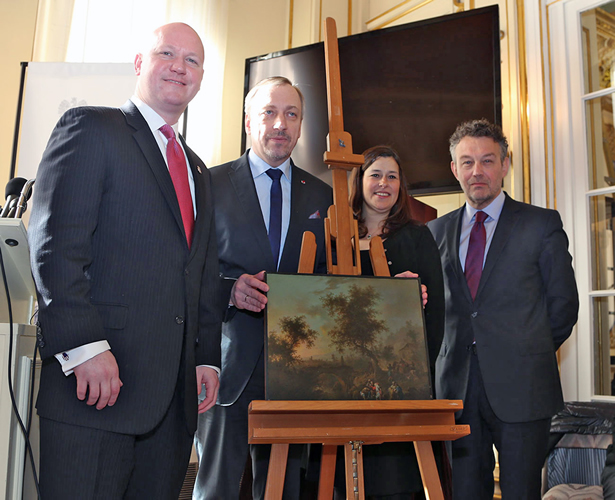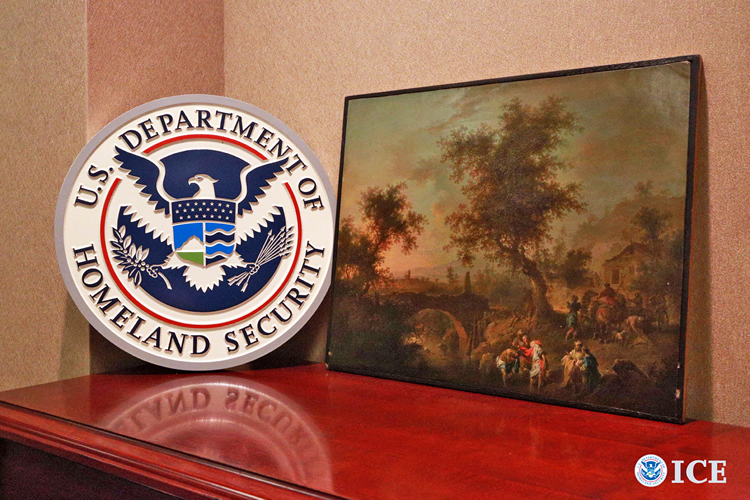ICE and Manhattan US attorney return Nazi-German looted painting to Poland
NEW YORK – More than seven decades after being stolen by the Nazis, the "Saint Philip Baptizing a Servant of Queen Kandaki" by German painter Johann Conrad Seekatz is back in the hands of the people of Poland. At a ceremony today at the Polish Consulate in New York, U.S. Immigration Customs and Enforcement's (ICE) Homeland Security Investigations (HSI) and the U.S. Attorney's Office for the Southern District of New York (SDNY), returned the painting to Poland Minister of Culture and National Heritage Bogdan Zdrojewski.
"Decades ago, during World War II, this Johann Conrad Seekatz painting was removed from its home in a national Polish museum by Nazi forces," said U.S. Attorney Preet Bharara, Southern District of New York. "Since then it has crisscrossed the globe, but today, we are very pleased to finally be able to return this Polish national treasure to the country and its people."
"I am very happy that another painting that was registered as a Polish wartime loss comes back to Poland today," said Minister of Culture and National Heritage Bogdan Zdrojewski. "Unfortunately, due to our tragic history, the database of Polish wartime losses is still enormous. However, the Polish government attaches a great importance to this issue as it’s one of our key priorities. Using this opportunity, I would like to thank the United States authorities involved in this difficult process for their close co-operation with my services that deal with wartime losses at the Ministry of Culture and National Heritage. It is our common success."
Shortly before his death in 1768, Seekatz created the painting. In December 1879, the National Museum in Warsaw received the painting from the Warsaw School of Fine Arts. In 1909, the Warsaw museum had the painting erroneously identified and listed as "St. Phillip Baptizes the Ethiopian Eunuch" by Dutch painter J.C. Saft.
In September 1939, during World War II, German forces invaded and occupied Warsaw. Between 1939 and 1945, they looted in Poland numerous works of art including the painting from the National Museum in Warsaw.
In June 2008, HSI New York special agents were notified by the Consulate General of the Republic of Poland that several national treasures of their cultural heritage looted during World War II were being offered for sale in the United States.
HSI New York agents met with Polish officials who provided supporting documentation to assist in the identification and recovery of the looted Polish work of art. HSI agents initiated an investigation and identified that the painting came into the possession of Doyle New York Auctioneers and Appraisers in about October 2006 and was sold under its erroneous name for approximately $24,000 to Rafael Valls Gallery in London.
An expert from the National Museum in Warsaw, delegated by the Polish Ministry of Culture and National Heritage, examined the painting in London with the full cooperation of the Rafael Valls Gallery and it was determined to be the same painting that was looted from Warsaw in 1944. In April 2012, HSI received an evaluation of the painting from the Ministry that the painting was identified as its true name and artist. Polish officials confirmed it was the same painting previously attributed to the artist J.C. Saft and registered as a Polish wartime loss of the National Museum in Warsaw in on-line database that the Polish Ministry of Culture and National Heritage runs. It is accessible also in English at http://kolekcje.mkidn.gov.pl/.
On July 12, 2012, after learning the painting was stolen, it was seized by HSI agents from the London gallery by stipulation order with the assistance of the U.S. Attorney’s Office SDNY. The painting was returned to New York from London leading to the Feb. 6 repatriation to the Republic of Poland.
In 2010 and 2011, ICE repatriated to the government of Poland a Polish army pre-1939 Regimental Standard (Banner) and two Julian Falat paintings, "The Hunt" and "Off to the Hunt" also known as "Before Going Hunting in Rytwiany."All these items were looted during WWII by the German-Nazis, illegally imported into the United States and later seized by HSI New York special agents.
HSI plays a leading role in criminal investigations that involve the illegal importation and distribution of cultural property, including the illicit trafficking of cultural property, especially objects that have been reported lost or stolen. The HSI Office of International Affairs, through its 67 attaché offices in 48 countries, works closely with foreign governments to conduct joint investigations, when possible.
HSI specially trained investigators, assigned to both domestic and international offices, partner with governments, agencies and experts to protect cultural antiquities. They also provide cultural property investigative training to law enforcement partners for crimes involving stolen property and art, and how to best enforce the law to recover these items when they emerge in the marketplace.
Since 2007, more than 7,150 artifacts have been returned to 27 countries, including paintings from France, Germany, Poland and Austria, 15th to 18th century manuscripts from Italy and Peru, as well as cultural artifacts from China, Cambodia and Iraq.
Learn more about HSI cultural property, art and antiquities investigations. Members of the public who have information about suspected stolen cultural property are urged to call the toll-free HSI tip line at 1-866-DHS-2-ICE or to complete its online tip form.



